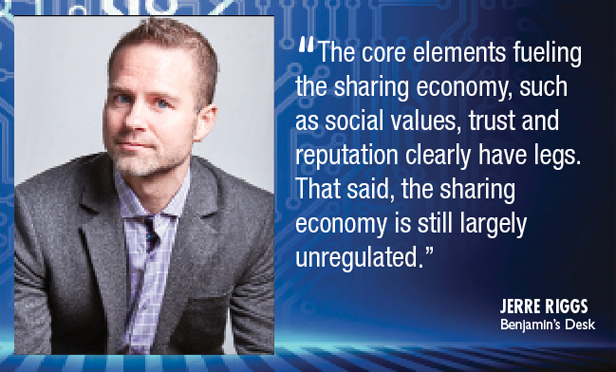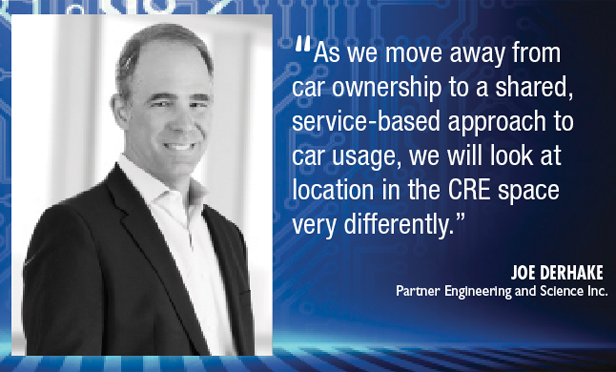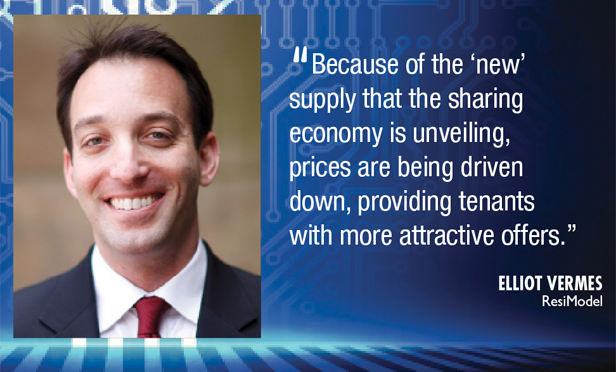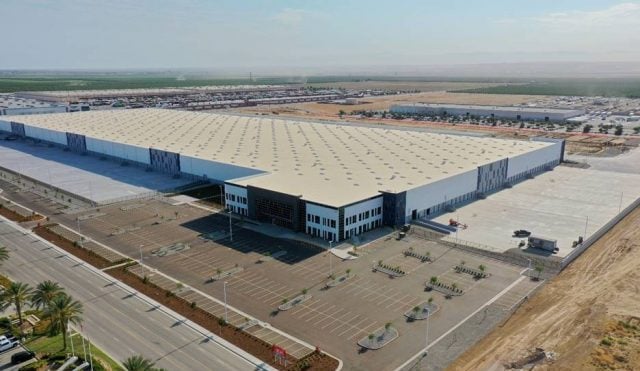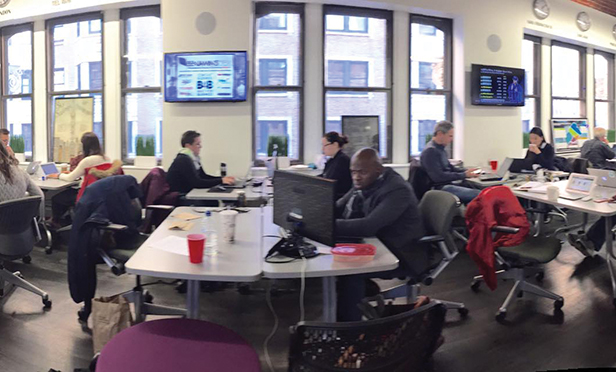
This is an HTML version of an article that ran in Real Estate Forum. To see the story in its original format, click here.
The commercial real estate industry has not traditionally been at the forefront of technological innovation—in fact, it often seems to play catch-up to other industries that have embraced technology wholeheartedly. But since technology-enabled companies like Airbnb and Uber, and co-working space providers like WeWork and Breather, have cropped up, CRE is being forced to either beat 'em or join 'em.
The data on sharing businesses made possible by technology is a true wakeup call for our industry. According to a recent CBRE study, “The Sharing Economy Checks In,” Airbnb is “the market leader as it relates to the temporary accommodations industry. The company's presence in key markets throughout the US is growing at a rapid pace, with users spending $2.4 billion on lodging in the US over the past year.” The company identified New York as the number-one domestic market at risk from the growth of Airbnb, followed by San Francisco, Miami, Oakland and Oahu.
It's no secret that the digital age has ushered in one of the biggest disrupters ever to the commercial real estate retail sector: e-commerce. Another CBRE article released on its Blueprint online magazine in July 2015, “How Connectivity Has Changed the Real Estate Game,” showed that mobile connectivity has helped e-commerce explode, with the US Department of Commerce reporting that e-commerce sales for the first quarter of 2015 were estimated at $80.3 billion, a 14.5% increase from the first quarter of 2014.”
At the recent SIOR Spring Conference in San Diego, moderator Steve Weikal of the MIT Center for Real Estate began the session “Real Disruption—The Sharing Economy and Commercial Real Estate” by revealing that venture-capital investment in real estate technology—the basis of most sharing-economy businesses—soared to $1.7 billion globally in 2015. “Tech follows the money,” he said. “The technology available to make real estate decisions is growing exponentially, with roughly 400 companies in this category currently being tracked.”
Weikal then went on to describe the sharing economy as a “collaborative consumption of resources.” Airbnb, the largest hotel company in the world, doesn't own a room, and Uber, the largest taxi service in the world, doesn't own a car. He said MIT Professor Dennis Frenchman calls this type of sharing economy “real estate fracking.” Meanwhile, companies like Breather, ZipCar and LiquidSpace hold leases and break them down to monetize them. Companies that use both techniques are on the rise in the sharing economy—from Clutter to Pipeline to PivotDesk, the latter of which utilizes empty desks/space within leased office space via monthly rentals to small companies and startups.
How has technology enabled the sharing economy to advance in the CRE realm? Jerre Riggs, director of real estate at Benjamin's Desk (a Philadelphia-based co-working community for mobile professionals, entrepreneurs and start-ups) and co-founder and COO of FirstBase (a start-up brokerage), tells Real Estate Forum, “Technology is enabling companies in the sharing economy to harness the power of Big Data number crunching, low-cost cloud storage, a myriad of social media platforms and prolific use of mobile devices to provide unprecedented access to goods, including real estate. Technology also is enabling the workforce to become increasingly untethered. More and more workers expect to work when, where and how they choose, which is reducing the need for 'traditional' office space. This has opened the doors for co-working and 'office as a service' providers to offer not only plug-and-play services, but also the flexibility necessary to cater to today's evolving workforce. The flexibility also benefits companies since they can now seriously think about reducing their traditional lease footprint, which is often the highest corporate cost outside of staffing.”
Joe Derhake, CEO of Partner Engineering and Science Inc., tells Forum that technologies which facilitate the collective pooling of knowledge, data or even funds have had a big impact in the CRE realm in recent years. “For example, crowdfunding platforms have opened doors to CRE investment for a much broader audience. And in our world of commercial real estate due diligence, data-sharing technologies (such as our SiteLynx platform) allow CRE professionals to obtain additional and more accurate data about the condition and performance of an asset or market. In that way, I see the sharing economy as enabling better risk management for those investing in or lending on commercial real estate.”
In order to have a sharing economy, you need the ability to database information and connect both those providing the service and those using it—and the technology of today can support that in a way that was simply impossible a few years ago, according to Elliot Vermes, CEO of ResiModel, a deal-management, analytics and valuation platform specifically designed for multifamily transactions. “For example, think of PivotDesk and Liquidspace, which are both in the business of micro-subletting office space. While the concept of leasing extraneous space is not revolutionary, the ability to do so on a grand scale, which has been a boon for landlords and tenants in recent years, has only recently become technologically viable.” Vermes adds that, much like Uber would be impossible without GPS, the real estate sharing economy would be impossible without advanced databases and other aspects of today's technology.
In addition, technology has brought both efficiency and access to the commercial real estate environment, says Allen Shayanfekr, CEO of Sharestates, an online service that matches investors with property owners looking for funding. “By creating and implementing software to automate analog tasks, companies are able to create a more scalable product. In addition, technology has allowed for firms like Sharestates to reach a much broader investor base, providing access to a previously inaccessible asset class—private real estate lending.”
Technology has also helped redefine what an office is and what it does. Julie Whelan, Americas head of occupier research for CBRE, tells Forum, “The emergence of digital innovations that are lightweight and easy-to-use, combined with cloud computing and mobile technologies, are reducing companies' need for a fixed office and IT infrastructure. This allows firms and individuals to work wherever, whenever and however.”
At the same time, there's been a dramatic increase in the number of self-employed people in the US, says Whelan. “All this freedom in terms of where to work, when to work and who to work with has also brought on a feeling of isolation for many. Co-working is a real estate model that fits into the sharing economy that has emerged from this dynamic. This model provides many of the amenities of traditional serviced offices, but places a much greater emphasis on space that creates a community and an experience for consumers.”
Remembering the dotcom era of the not-too-distant past, followed by the Great Recession, we are inclined to wonder which elements of the sharing economy, enabled by technology, have “legs” vs. those that will eventually die out. Riggs says, “The core elements fueling the sharing economy, such as social values, trust and reputation clearly have legs. That said, the sharing economy is still largely unregulated. If that changes and regulation suppresses the potential benefits of new business models, there is obviously some risk to companies focused on providing access within the sharing economy. Because that has not yet happened, it's difficult to predict which elements could eventually die out.”
Derhake says he expects elements of the sharing economy that not only cut costs for users but also increase convenience to endure. “In the real estate space, co-working companies like WeWork (which allows people to rent office space on an as-needed basis), or start-ups like Common (a membership-based service that offers co-living spaces) and accommodation-sharing services like Airbnb all provide real estate at a discounted rate and make it easy for users to walk away, no strings attached, as soon as they don't need it anymore. This convenience and the flexibility that it provides will continue to grow the popularity of these services.”
The sharing economy exists because technology has given people access to conduct peer-to-peer transactions, says Shayanfekr. “The access piece is definitely the key to success. The biggest hurdle comes when regulation steps in, which could cause parts of the sharing economy to change.”
What implications does the sharing economy have for the commercial real estate industry now and in the future? Riggs says one of the biggest implications is the ability to make better use of fixed assets by matching people with shared space, including co-working spaces, which continue to see tremendous year-over-year growth. “Developers and landlords will need to start factoring these spaces in to their buildings or portfolios because the demand will continue to grow.”
Whelan points out that Investopedia defines the sharing economy as “'an economic model in which individuals are able to borrow or rent assets owned by someone else. The sharing economy model is most likely to be used when the price of a particular asset is high and the asset is not fully utilized all the time.' So, by definition, the landlord and tenant relationship has always been part of the sharing economy. However, the innovation we see in the industry today is focused around creating a more efficient supply-and-demand dynamic around space utilization, specifically in high-cost markets through co-working.”
She notes that currently there are more than 7,000 co-working facilities around the globe, a number that's projected to increase to more than 10,000 by the end of 2016, according to DeskMag. “This is a model that is compelling to users that employ it; however, it is not without its challenges. It will take time to see how viable this model is through economic cycles.”
One area of our infrastructure that stands to change the most is transportation, which will also revolutionize CRE. Derhake says, “Technologies that change how we use cars—particularly ride-share services like Uber, ZipCar and the advent of driverless cars—will have a fundamental impact on the commercial real estate industry. In the '50s, personal car ownership was the mother of suburbia. As we move away from car ownership to a shared, service-based approach to car usage, we will look at location in the CRE space very differently.” For example, proximity to public transport or the availability of ample parking will no longer dictate what's considered to be a “good location.”
The sharing economy may also change the value proposition of some buildings. “An app-based shared-car service that picks you up and drops you off wherever you want to go doesn't need the car to wait around for you, and therefore eliminates the need for vast parking structures in prime locations,” says Derhake. “Instead, it creates a new need for high-capacity pick-up/drop-off locations. CRE professionals should be thinking about how this shared-car culture could create a risk of obsolescence of certain real estate assets.”
Vermes believes the sharing economy will help optimize usage of a scarce resource now and in the future. “In the aviation industry, revenue-optimization technologies—sophisticated algorithms that alter the price of tickets depending on a variety of factors—have enabled airlines to fly planes that are, on average, much fuller than several decades ago. This has reduced the airline's average cost to fly a person, which has been a boon for the industry.”
The sharing economy has the ability to do something similar to real estate. With PivotDesk and Liquidspace, office landlords have the ability to micro-sublet extra space, monetizing what would otherwise languish as unused offices, he notes. “And because of the 'new' supply that the sharing economy is unveiling, prices are driven down, providing tenants with more attractive offers.”
Vermes adds that with Airbnb, both apartment dwellers and homeowners can leverage the sharing economy to bring in money. Vacationers, meanwhile, benefit from lower prices than they would find at traditional hotels. “While some apartment landlords are currently opposed to services like Airbnb, several of the country's largest landlords have already begun discussions with Airbnb about arranging revenue-sharing agreements with the platform. In the future, we are likely to see a growing number of major landlords embrace Airbnb.”
In essence, the sharing economy lets people use their resources more efficiently, which has the same impact as increasing supply—benefiting both landlords and tenants, says Vermes. “For landlords, it allows them to monetize a greater portion of their real estate assets. For tenants, the increase in supply can help drive down pricing. The sharing economy's broader implications on real estate may be even more significant, since an ecosystem that uses both residential and commercial buildings more efficiently will require fewer buildings, which would also help eliminate urban sprawl.”
We're seeing commercial real estate investment change before our eyes, through crowdfunding and marketplace lending, Shayanfekr points out. “More and more individuals are going to continue to see real estate crowdfunding as a better solution for investing—one that's easy, passive and transparent. Since the loans are backed by real assets, the risk of the investment is lower and much less stressful compared to the equities market.”

This is an HTML version of an article that ran in Real Estate Forum. To see the story in its original format, click here.
The commercial real estate industry has not traditionally been at the forefront of technological innovation—in fact, it often seems to play catch-up to other industries that have embraced technology wholeheartedly. But since technology-enabled companies like Airbnb and Uber, and co-working space providers like WeWork and Breather, have cropped up, CRE is being forced to either beat 'em or join 'em.
The data on sharing businesses made possible by technology is a true wakeup call for our industry. According to a recent CBRE study, “The Sharing Economy Checks In,” Airbnb is “the market leader as it relates to the temporary accommodations industry. The company's presence in key markets throughout the US is growing at a rapid pace, with users spending $2.4 billion on lodging in the US over the past year.” The company identified
It's no secret that the digital age has ushered in one of the biggest disrupters ever to the commercial real estate retail sector: e-commerce. Another CBRE article released on its Blueprint online magazine in July 2015, “How Connectivity Has Changed the Real Estate Game,” showed that mobile connectivity has helped e-commerce explode, with the US Department of Commerce reporting that e-commerce sales for the first quarter of 2015 were estimated at $80.3 billion, a 14.5% increase from the first quarter of 2014.”
At the recent SIOR Spring Conference in San Diego, moderator Steve Weikal of the MIT Center for Real Estate began the session “Real Disruption—The Sharing Economy and Commercial Real Estate” by revealing that venture-capital investment in real estate technology—the basis of most sharing-economy businesses—soared to $1.7 billion globally in 2015. “Tech follows the money,” he said. “The technology available to make real estate decisions is growing exponentially, with roughly 400 companies in this category currently being tracked.”
Weikal then went on to describe the sharing economy as a “collaborative consumption of resources.” Airbnb, the largest hotel company in the world, doesn't own a room, and Uber, the largest taxi service in the world, doesn't own a car. He said MIT Professor Dennis Frenchman calls this type of sharing economy “real estate fracking.” Meanwhile, companies like Breather, ZipCar and LiquidSpace hold leases and break them down to monetize them. Companies that use both techniques are on the rise in the sharing economy—from Clutter to Pipeline to PivotDesk, the latter of which utilizes empty desks/space within leased office space via monthly rentals to small companies and startups.
How has technology enabled the sharing economy to advance in the CRE realm? Jerre Riggs, director of real estate at Benjamin's Desk (a Philadelphia-based co-working community for mobile professionals, entrepreneurs and start-ups) and co-founder and COO of FirstBase (a start-up brokerage), tells Real Estate Forum, “Technology is enabling companies in the sharing economy to harness the power of Big Data number crunching, low-cost cloud storage, a myriad of social media platforms and prolific use of mobile devices to provide unprecedented access to goods, including real estate. Technology also is enabling the workforce to become increasingly untethered. More and more workers expect to work when, where and how they choose, which is reducing the need for 'traditional' office space. This has opened the doors for co-working and 'office as a service' providers to offer not only plug-and-play services, but also the flexibility necessary to cater to today's evolving workforce. The flexibility also benefits companies since they can now seriously think about reducing their traditional lease footprint, which is often the highest corporate cost outside of staffing.”
Joe Derhake, CEO of Partner Engineering and Science Inc., tells Forum that technologies which facilitate the collective pooling of knowledge, data or even funds have had a big impact in the CRE realm in recent years. “For example, crowdfunding platforms have opened doors to CRE investment for a much broader audience. And in our world of commercial real estate due diligence, data-sharing technologies (such as our SiteLynx platform) allow CRE professionals to obtain additional and more accurate data about the condition and performance of an asset or market. In that way, I see the sharing economy as enabling better risk management for those investing in or lending on commercial real estate.”
In order to have a sharing economy, you need the ability to database information and connect both those providing the service and those using it—and the technology of today can support that in a way that was simply impossible a few years ago, according to Elliot Vermes, CEO of ResiModel, a deal-management, analytics and valuation platform specifically designed for multifamily transactions. “For example, think of PivotDesk and Liquidspace, which are both in the business of micro-subletting office space. While the concept of leasing extraneous space is not revolutionary, the ability to do so on a grand scale, which has been a boon for landlords and tenants in recent years, has only recently become technologically viable.” Vermes adds that, much like Uber would be impossible without GPS, the real estate sharing economy would be impossible without advanced databases and other aspects of today's technology.
In addition, technology has brought both efficiency and access to the commercial real estate environment, says Allen Shayanfekr, CEO of Sharestates, an online service that matches investors with property owners looking for funding. “By creating and implementing software to automate analog tasks, companies are able to create a more scalable product. In addition, technology has allowed for firms like Sharestates to reach a much broader investor base, providing access to a previously inaccessible asset class—private real estate lending.”
Technology has also helped redefine what an office is and what it does. Julie Whelan, Americas head of occupier research for CBRE, tells Forum, “The emergence of digital innovations that are lightweight and easy-to-use, combined with cloud computing and mobile technologies, are reducing companies' need for a fixed office and IT infrastructure. This allows firms and individuals to work wherever, whenever and however.”
At the same time, there's been a dramatic increase in the number of self-employed people in the US, says Whelan. “All this freedom in terms of where to work, when to work and who to work with has also brought on a feeling of isolation for many. Co-working is a real estate model that fits into the sharing economy that has emerged from this dynamic. This model provides many of the amenities of traditional serviced offices, but places a much greater emphasis on space that creates a community and an experience for consumers.”
Remembering the dotcom era of the not-too-distant past, followed by the Great Recession, we are inclined to wonder which elements of the sharing economy, enabled by technology, have “legs” vs. those that will eventually die out. Riggs says, “The core elements fueling the sharing economy, such as social values, trust and reputation clearly have legs. That said, the sharing economy is still largely unregulated. If that changes and regulation suppresses the potential benefits of new business models, there is obviously some risk to companies focused on providing access within the sharing economy. Because that has not yet happened, it's difficult to predict which elements could eventually die out.”
Derhake says he expects elements of the sharing economy that not only cut costs for users but also increase convenience to endure. “In the real estate space, co-working companies like WeWork (which allows people to rent office space on an as-needed basis), or start-ups like Common (a membership-based service that offers co-living spaces) and accommodation-sharing services like Airbnb all provide real estate at a discounted rate and make it easy for users to walk away, no strings attached, as soon as they don't need it anymore. This convenience and the flexibility that it provides will continue to grow the popularity of these services.”
The sharing economy exists because technology has given people access to conduct peer-to-peer transactions, says Shayanfekr. “The access piece is definitely the key to success. The biggest hurdle comes when regulation steps in, which could cause parts of the sharing economy to change.”
What implications does the sharing economy have for the commercial real estate industry now and in the future? Riggs says one of the biggest implications is the ability to make better use of fixed assets by matching people with shared space, including co-working spaces, which continue to see tremendous year-over-year growth. “Developers and landlords will need to start factoring these spaces in to their buildings or portfolios because the demand will continue to grow.”
Whelan points out that Investopedia defines the sharing economy as “'an economic model in which individuals are able to borrow or rent assets owned by someone else. The sharing economy model is most likely to be used when the price of a particular asset is high and the asset is not fully utilized all the time.' So, by definition, the landlord and tenant relationship has always been part of the sharing economy. However, the innovation we see in the industry today is focused around creating a more efficient supply-and-demand dynamic around space utilization, specifically in high-cost markets through co-working.”
She notes that currently there are more than 7,000 co-working facilities around the globe, a number that's projected to increase to more than 10,000 by the end of 2016, according to DeskMag. “This is a model that is compelling to users that employ it; however, it is not without its challenges. It will take time to see how viable this model is through economic cycles.”
One area of our infrastructure that stands to change the most is transportation, which will also revolutionize CRE. Derhake says, “Technologies that change how we use cars—particularly ride-share services like Uber, ZipCar and the advent of driverless cars—will have a fundamental impact on the commercial real estate industry. In the '50s, personal car ownership was the mother of suburbia. As we move away from car ownership to a shared, service-based approach to car usage, we will look at location in the CRE space very differently.” For example, proximity to public transport or the availability of ample parking will no longer dictate what's considered to be a “good location.”
The sharing economy may also change the value proposition of some buildings. “An app-based shared-car service that picks you up and drops you off wherever you want to go doesn't need the car to wait around for you, and therefore eliminates the need for vast parking structures in prime locations,” says Derhake. “Instead, it creates a new need for high-capacity pick-up/drop-off locations. CRE professionals should be thinking about how this shared-car culture could create a risk of obsolescence of certain real estate assets.”
Vermes believes the sharing economy will help optimize usage of a scarce resource now and in the future. “In the aviation industry, revenue-optimization technologies—sophisticated algorithms that alter the price of tickets depending on a variety of factors—have enabled airlines to fly planes that are, on average, much fuller than several decades ago. This has reduced the airline's average cost to fly a person, which has been a boon for the industry.”
The sharing economy has the ability to do something similar to real estate. With PivotDesk and Liquidspace, office landlords have the ability to micro-sublet extra space, monetizing what would otherwise languish as unused offices, he notes. “And because of the 'new' supply that the sharing economy is unveiling, prices are driven down, providing tenants with more attractive offers.”
Vermes adds that with Airbnb, both apartment dwellers and homeowners can leverage the sharing economy to bring in money. Vacationers, meanwhile, benefit from lower prices than they would find at traditional hotels. “While some apartment landlords are currently opposed to services like Airbnb, several of the country's largest landlords have already begun discussions with Airbnb about arranging revenue-sharing agreements with the platform. In the future, we are likely to see a growing number of major landlords embrace Airbnb.”
In essence, the sharing economy lets people use their resources more efficiently, which has the same impact as increasing supply—benefiting both landlords and tenants, says Vermes. “For landlords, it allows them to monetize a greater portion of their real estate assets. For tenants, the increase in supply can help drive down pricing. The sharing economy's broader implications on real estate may be even more significant, since an ecosystem that uses both residential and commercial buildings more efficiently will require fewer buildings, which would also help eliminate urban sprawl.”
We're seeing commercial real estate investment change before our eyes, through crowdfunding and marketplace lending, Shayanfekr points out. “More and more individuals are going to continue to see real estate crowdfunding as a better solution for investing—one that's easy, passive and transparent. Since the loans are backed by real assets, the risk of the investment is lower and much less stressful compared to the equities market.”
© Touchpoint Markets, All Rights Reserved. Request academic re-use from www.copyright.com. All other uses, submit a request to [email protected]. For more inforrmation visit Asset & Logo Licensing.

